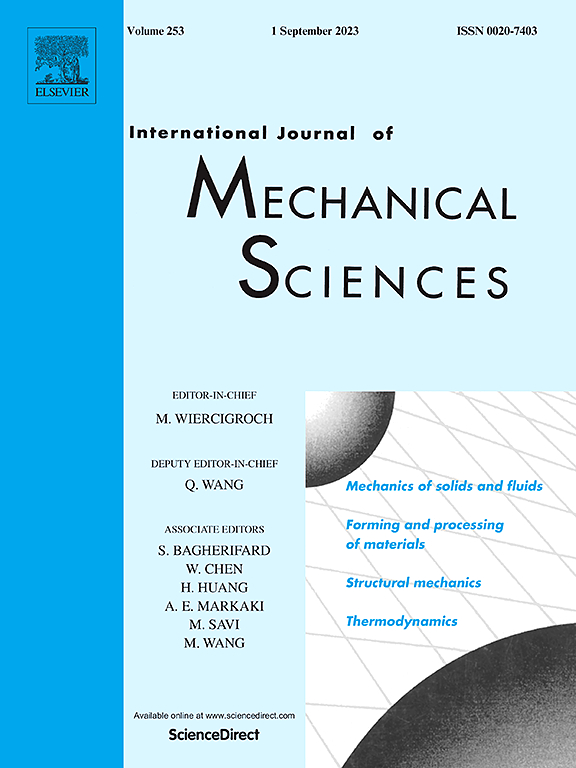铜裂纹晶界相互作用的原子模拟
IF 7.1
1区 工程技术
Q1 ENGINEERING, MECHANICAL
International Journal of Mechanical Sciences
Pub Date : 2025-04-28
DOI:10.1016/j.ijmecsci.2025.110318
引用次数: 0
摘要
晶界是纳米晶金属的重要结构特征,在协调金属塑性变形中起着重要作用。在准三维情况下,GB结构由三个几何参数决定,即GB倾角和两种成形晶粒的晶体取向,这两个几何参数决定了GB错取向角。本文研究了GB的几何参数对裂纹扩展行为的影响。采用一种新颖的数独采样方法确定了预裂双晶试样的几何参数,并进行了广泛的分子动力学(MD)模拟。数独采样是基于数独游戏的唯一行、列不重复规则,在采样空间内实现均匀采样,同时降低计算成本。从MD模拟结果可以看出裂纹尖端钝化、沿晶滑动、穿晶裂纹、穿晶滑动和沿晶裂纹五种裂纹模式。结果表明,裂纹扩展的最大影响因素是试样倾角,试样倾角越小,裂纹扩展阻力越小。GB错向角的影响次之,较大的错向角有利于晶间裂纹的扩展。本研究加深了对晶界对纳米晶金属断裂行为影响的认识,对通过GB工程策略开发抗损伤材料具有指导意义。本文章由计算机程序翻译,如有差异,请以英文原文为准。

Atomistic simulations of crack grain-boundary interactions in copper
Grain boundaries (GBs) are important structural features and play an important role in coordinating the plastic deformation of nanocrystalline metals. In the quasi-3D case, the GB structure is determined by three geometric parameters, that is, the GB inclination angle and the crystal orientations of the two forming grains which determine the GB misorientation angle. In this paper, the effects of geometric parameters of the GB on the crack propagation behavior are investigated. Extensive molecular dynamics (MD) simulations are carried out to simulate the uniaxial tension of a series of pre-cracked bicrystal specimens, whose geometric parameters are determined using a novel Sudoku sampling method. Sudoku sampling is based on the unique row and column non-repeat rule of the Sudoku game to achieve uniform sampling in the sampling space, and at the same time to reduce the computational cost. From the MD simulation results five patterns of cracking modes can be discerned, i.e., crack tip blunting, intergranular sliding, transgranular cracking, transgranular sliding and intergranular cracking. It indicates that the GB inclination angle is the most influential factor for the crack propagation behavior, with smaller GB inclination angle corresponding to smaller crack propagation resistance. The GB misorientation angle is second influential, with a large misorientation angle favoring the intergranular crack propagation. This study deepens the understanding of effect of grain boundaries on the fracture behavior in nanocrystalline metals, which guides the development of damage-resistant materials through GB engineering strategy.
求助全文
通过发布文献求助,成功后即可免费获取论文全文。
去求助
来源期刊

International Journal of Mechanical Sciences
工程技术-工程:机械
CiteScore
12.80
自引率
17.80%
发文量
769
审稿时长
19 days
期刊介绍:
The International Journal of Mechanical Sciences (IJMS) serves as a global platform for the publication and dissemination of original research that contributes to a deeper scientific understanding of the fundamental disciplines within mechanical, civil, and material engineering.
The primary focus of IJMS is to showcase innovative and ground-breaking work that utilizes analytical and computational modeling techniques, such as Finite Element Method (FEM), Boundary Element Method (BEM), and mesh-free methods, among others. These modeling methods are applied to diverse fields including rigid-body mechanics (e.g., dynamics, vibration, stability), structural mechanics, metal forming, advanced materials (e.g., metals, composites, cellular, smart) behavior and applications, impact mechanics, strain localization, and other nonlinear effects (e.g., large deflections, plasticity, fracture).
Additionally, IJMS covers the realms of fluid mechanics (both external and internal flows), tribology, thermodynamics, and materials processing. These subjects collectively form the core of the journal's content.
In summary, IJMS provides a prestigious platform for researchers to present their original contributions, shedding light on analytical and computational modeling methods in various areas of mechanical engineering, as well as exploring the behavior and application of advanced materials, fluid mechanics, thermodynamics, and materials processing.
 求助内容:
求助内容: 应助结果提醒方式:
应助结果提醒方式:


